Current and Future Potential Distribution of the Xerophytic Shrub Candelilla (Euphorbia antisyphilitica) under Two Climate Change Scenarios
Abstract
:1. Introduction
2. Materials and Methods
3. Results
3.1. Projections of Current Candelilla’s Presence
3.2. Future Potential Sites for Distribution of Candelilla
4. Discussion
5. Conclusions
Author Contributions
Funding
Acknowledgments
Conflicts of Interest
References
- Scora, G.A.; Ahmed, M.; Scora, R.W. Epicuticular hydrocarbons of candelilla (Euphorbia antisiphylitica) from three different geographical areas. Ind. Crop. Prod. 1995, 4, 179–184. [Google Scholar] [CrossRef]
- Barsch, F. Candelilla (Euphorbia antisyphilitica): Utilization in Mexico and international trade. Med. Plant. Conserv. 2004, 9, 46–50. [Google Scholar]
- Webster, G.L. Synopsis of the genera and suprageneric taxa of Euphorbiaceae. Ann. Missour Ibot. Gard. 1994, 81, 33–144. [Google Scholar] [CrossRef]
- Horn, J.W.; van Ee, B.W.; Morawetz, J.J.; Riina, R.; Steinmann, V.W.; Berry, P.E.; Wurdack, K.J. Phylogenetics and the evolution of major structural characters in the giant genus Euphorbia L. (Euphorbiaceae). Mol. Phylogenet. Evol. 2012, 63, 305–326. [Google Scholar] [CrossRef]
- Martínez-Ballesté, A.; Mandujano, M.C. The consequences of harvesting on regeneration of a non-timber wax producing species (Euphorbia antisyphilitica Zucc.) of the Chihuahuan Desert. Econ. Bot. 2013, 67, 124–136. [Google Scholar] [CrossRef]
- Flores-del Ángel, M.; Foroughbakhch, R.; Rocha-Estrada, A.; Cárdenas-Ávila, M.; Guzmán-Lucio, M.; Hernández-Aguilar, Y.; Alvarado-Vázquez, M. Morfología, viabilidad y germinación de semillas de candelilla (Euphorbia antisyphilitica Zucc.). Phyton 2013, 82, 161–167. [Google Scholar]
- Ochoa-Reyes, E.; Saucedo-Pompa, S.; De La Garza, H.; Martínez, D.G.; Rodríguez, R.; Aguilar-Gonzalez, C.N. Extracción tradicional de cera de Euphorbia antysiphilitica. Rev. Científica De La Univ. Autónoma De Coahuila 2010, 2, 1–13. [Google Scholar]
- Rojas Molina, R.; Saucedo Pompa, S.; De León Zapata, M.A.; Jasso Cantú, D.; Aguilar, C.N. Pasado, presente y futuro de la candelilla. Rev. Mex. Cienc. For. 2011, 2, 7–18. [Google Scholar] [CrossRef] [Green Version]
- Martínez-Salvador, M.; Hermosillo-Rojas, D.E.; Mojica-Guerrero, A.; Prieto-Amparan, J.A. Potencial Productivo y Zonificación Para el uso y Manejo de Especies Forestales de Zonas Áridas; INIFAP: Chihuahua, México, 2015; Volume 1, p. 119. [Google Scholar]
- Resendez, A.M.; Hernández-Herrera, J.A.; Va0lenzuela-Núñez, L.M.; Martínez-Salvador, M. Modelación de la presencia de Euphorbia antisyphilitica Zucc mediante propiedades físicas y químicas del suelo. Ecosistemas Y Recur. Agropecu. 2019, 6, 499–511. [Google Scholar]
- Alvarado, C.J.C.; Galindo, A.S.; Bermúdez, L.B.; Berumen, C.P.; Orta, C.Á.; Garza, J.A.V. Cera de Candelilla y sus aplicaciones. Av. En Química 2013, 8, 105–110. [Google Scholar]
- Rojas-Molina, R.; De León-Zapata, M.; Saucedo-Pompa, S.; Aguilar-Gonzalez, M.; Aguilar, C. Chemical and structural characterization of Candelilla (Euphorbia antisyphilitica Zucc.). J. Med. Plants Res. 2013, 7, 702–705. [Google Scholar]
- Tapia-Tapia, E.D.C.; Reyes-Chilpa, R. Productos forestales no maderables en México: Aspectos económicos para el desarrollo sustentable. Madera Y Bosques 2008, 14, 95–112. [Google Scholar] [CrossRef]
- Luna, E.V.; Barriada-Bernal, L.G.; Lopez-Diaz, S.; Villa, F.C.; Medrano, J.R.M. Effect of abiotic stress conditions on the wax production in candelilla (Euphorbia antisyphilitica zucc.). Rev. Latinoam. De Química 2016, 44, 7. [Google Scholar]
- Villarreal-Quintanilla, J.A.; Bartolomé-Hernández, J.A.; Estrada-Castillón, E.; Ramírez-Rodríguez, H.; Martínez-Amador, S.J. El elemento endémico de la flora vascular del Desierto Chihuahuense. Acta Botánica Mex. 2017, 118, 65–96. [Google Scholar] [CrossRef]
- García, E. Modificaciones al Sistema de Clasificación Climática de Köppen, Para Adaptarlo a los Climas de la República Mexicana, 4th ed.; UNAM: Mexico City, Mexico; Instituto de Geografía: Mexico City, Mexico, 2004; Volume 1, 90p. [Google Scholar]
- Granados-Sánchez, D.; Sánchez-González, A.; Victorino, R.L.G.; Rosa, A.B.D.L. Ecología de la vegetación del Desierto Chihuahuense. Rev. Chapingo Ser. Cienc. For. Y Del Ambiente 2011, 17, 111–130. [Google Scholar] [CrossRef]
- Cortes, L.; Dominguez, I.; Lebgue, T.; Viramontes, O.; Melgoza, A.; Pinedo, C.; Camarillo, J. Variation in the distribution of four cacti species due to climate change in Chihuahua, Mexico. Int J. Environ. Res. Public Health 2013, 11, 390–402. [Google Scholar] [CrossRef] [Green Version]
- Maciel-Mata, C.A.; Manríquez-Morán, N.; Octavio-Aguilar, P.; Sánchez-Rojas, G. El área de distribución de las especies: Revisión del concepto. Acta Univ. 2015, 25, 3–19. [Google Scholar]
- Grotch, S.L.; MacCracken, M.C. The use of general circulation models to predict regional climatic change. J. Clim. 1991, 4, 286–303. [Google Scholar] [CrossRef] [Green Version]
- Elith, J.; Graham, C.H.; Anderson, R.P.; Dudík, M.; Ferrier, S.; Guisan, A.; Hijmans, R.J.; Huettmann, F.; Leathwick, J.R.; Lehmann, A.; et al. Novel methods improve prediction of species’ distributions from occurrence data. Ecography 2006, 29, 129–151. [Google Scholar] [CrossRef] [Green Version]
- Seo, C.; Thorne, J.H.; Hannah, L.; Thuiller, W. Scale effects in species distribution models: Implications for conservation planning under climate change. Biol. Lett. 2009, 5, 39–43. [Google Scholar] [CrossRef] [Green Version]
- Hernandez, P.A.; Graham, C.H.; Master, L.L.; Albert, D.L. The effect of sample size and species characteristics on performance of different species distribution modeling methods. Ecography 2006, 29, 773–785. [Google Scholar] [CrossRef]
- Warren, D.L.; Seifert, S.N. Ecological niche modeling in Maxent: The importance of model complexity and the performance of model selection criteria. Ecol. Appl. 2011, 21, 335–342. [Google Scholar] [CrossRef] [PubMed] [Green Version]
- Baek, H.; Lee, J.; Lee, H.; Hyun, Y.; Cho, C.; Kwon, W.; Marzin, C.; Gan, S.; Kim, M.; Choi, D. Climate change in the 21st century simulated by HadGEM2-AO under representative concentration pathways. Asia-Pac. J. Atmos. Sci. 2013, 49, 603–618. [Google Scholar] [CrossRef]
- Wei, B.; Wang, R.; Hou, K.; Wang, X.; Wu, W. Predicting the current and future cultivation regions of Carthamus tinctorius L. using MaxEnt model under climate change in China. Glob. Ecol. Conserv. 2018, 16, e00477. [Google Scholar]
- GBIF.org, Occurrence Download; GBIF: Copenhagen, Denmark, 2019; Available online: https://www.gbif.org (accessed on 8 July 2019).
- Huettmann, F. Databases and science-based management in the context of wildlife and habitat: Toward a certified ISO standard for objective decision-making for the global community by using the internet. J. Wildl. Manag. 2005, 69, 466–472. [Google Scholar] [CrossRef]
- Hijmans, R.; Garrett, K.; Huaman, Z.; Zhang, D.; Schreuder, M.; Bonierbale, M. Assessing the geographic representativeness of genebank collections: The case of Bolivian wild potatoes. Conserv. Biol. 2000, 14, 1755–1765. [Google Scholar] [CrossRef]
- Reese, G.C.; Wilson, K.R.; Hoeting, J.A.; Flather, C.H. Factors affecting species distribution predictions: A simulation modeling experiment. Ecol. Appl. 2005, 15, 554–564. [Google Scholar] [CrossRef] [Green Version]
- INIFAP-CONABIO. Inventario Nacional de Candelilla (Euphorbia antisyphilitica) Fase I Version 1.5. Occurrence dataset. In Inventario Nacional de Candelilla (Euphorbia antisyphilitica); CONABIO: Mexico City, Mexico, 2018. [Google Scholar]
- Elith, J.; Leathwick, J.R. Species distribution models: Ecological Explanation and Prediction Across Space and Time. Annu. Rev. Ecol. Evol. Syst. 2009, 40, 677–697. [Google Scholar] [CrossRef]
- Guisan, A.; Thuiller, W. Predicting species distribution: Offering more than simple habitat models. Ecol. Lett. 2005, 10, 993–1009. [Google Scholar] [CrossRef]
- Li, G.Q.; Liu, C.C.; Liu, Y.G.; Yang, J.; Zhang, X.S.; Guo, K. Advances in theoretical issues of species distributionmodels. Acta Ecol. Sin. 2013, 36, 4827–4835. [Google Scholar]
- Wang, R.; Li, Q.; He, S.; Liu, Y.; Wang, M.; Jiang, G. Modeling and mapping the current and future distribution of Pseudomonas syringae pv. actinidiae under climate change in China. PLoS ONE 2018, 13, e0192153. [Google Scholar] [CrossRef] [PubMed] [Green Version]
- Soberón, J.; Osorio-Olvera, L.; Peterson, T. Diferencias conceptuales entre modelación de nichos y modelación de áreas de distribución. Rev. Mex. De Biodivers. 2017, 88, 437–441. [Google Scholar] [CrossRef]
- Gastón, A.; García-Viñas, J.I. Modelling species distributions with penalised logistic regressions: A comparison with maximum entropy models. Ecol. Model. 2011, 222, 2037–2041. [Google Scholar] [CrossRef]
- Phillips, S.J.; Dudík, M.; Schapire, R.E. A Maximum entropy approach to species distribution modeling. In Proceedings of the Twenty-First International Conference on Machine Learning, Banff, AB, Canada, 4–8 July 2004; Volume 83, pp. 655–662. [Google Scholar]
- Elith, J.; Phillips, S.J.; Hastie, T.; Dudík, M.; Chee, Y.E.; Yates, C.J. A statistical explanation of MaxEnt for ecologists. Divers. Distrib. 2011, 17, 43–57. [Google Scholar] [CrossRef]
- Ortíz-Yusty, C.; Restrepo, A.; Páez, V.P. Distribución potencial de Podocnemis lewyana (Reptilia: Podocnemididae) y su posible fluctuación bajo escenarios de cambio climático global. Acta Biol. Colomb. 2014, 13, 471–481. [Google Scholar] [CrossRef]
- Martin, G.; Bellouin, N.; Collins, W.; Culverwell, I.; Halloran, P.; Hardiman, S.; Hinton, T.; Jones, C.; McDonald, R.; McLaren, A. The HadGEM2 family of Met Office Unified Model climate configurations. Geosci. Model. Dev. 2011, 4, 723–757. [Google Scholar]
- Taylor, K.E.; Stouffer, R.J.; Meehl, G.A. An overview of CMIP5 and the experiment design. Bull. Am. Meteorol. Soc. 2012, 93, 485–498. [Google Scholar] [CrossRef] [Green Version]
- Hijmans, R.J.; Cameron, S.; Parra, J.; Jones, P.; Jarvis, A.; Richardson, K. World Clim-Global Climate Data. Free Climate Data for Ecological Modeling and GIS. 2015, Volume 2.0. Available online: www.worldclim.org (accessed on 8 July 2019).
- Giorgetta, M.A.; Jungclaus, J.; Reick, C.H.; Legutke, S.; Bader, J.; Böttinger, M.; Brovkin, V.; Crueger, T.; Esch, M.; Fieg, K. Climate and carbon cycle changes from 1850 to 2100 in MPI-ESM simulations for the Coupled Model Intercomparison Project phase 5. J. Adv. Model. Earth Syst. 2013, 5, 572–597. [Google Scholar] [CrossRef]
- Griffies, S.M.; Winton, M.; Donner, L.J.; Horowitz, L.W.; Downes, S.M.; Farneti, R.; Gnanadesikan, A.; Hurlin, W.J.; Lee, H.-C.; Liang, Z. The GFDL CM3 coupled climate model: Characteristics of the ocean and sea ice simulations. J. Clim. 2011, 24, 3520–3544. [Google Scholar] [CrossRef]
- Good, P.; Jones, C.; Lowe, J.; Betts, R.; Gedney, N. Comparing tropical forest projections from two generations of Hadley Centre Earth System models, HadGEM2-ES and HadCM3LC. J. Clim. 2013, 26, 495–511. [Google Scholar] [CrossRef]
- Qin, A.; Liu, B.; Guo, Q.; Bussmann, R.W.; Ma, F.; Jian, Z.; Xu, G.; Pei, S. Maxent modeling for predicting impacts of climate change on the potential distribution of Thuja sutchuenensis Franch., an extremely endangered conifer from southwestern China. Glob. Ecol. Conserv. 2017, 10, 139–146. [Google Scholar] [CrossRef]
- Cook, B.I.; Ault, T.R.; Smerdon, J.E. Unprecedented 21st century drought risk in the American Southwest and Central Plains. Sci. Adv. 2015, 1, e1400082. [Google Scholar] [CrossRef] [PubMed] [Green Version]
- Fernández-Eguiarte, A.; Zavala-Hidalgo, J.; Romero-Centeno, R. Atlas Climático Digital de México. Centro de Ciencias de la Atmósfera; UNAM Centro de Ciencias de la Atmosfera: Mexico City, Mexico, 2010; Volume 1, p. 2. [Google Scholar]
- Phillips, S.J.; Anderson, R.P.; Schapire, R.E. Maximum entropy modeling of species geographic distributions. Ecol. Model. 2006, 190, 231–259. [Google Scholar] [CrossRef] [Green Version]
- Jaynes, E.T. Information theory and statistical mechanics. Phys. Rev. 1957, 106, 620. [Google Scholar] [CrossRef]
- Phillips, S.J.; Dudík, M. Modeling of species distributions with Maxent: New extensions and a comprehensive evaluation. Ecography 2008, 31, 161–175. [Google Scholar] [CrossRef]
- Torres-Olave, M.E. Aproximación espacio-temporal de sus scrofa en Chihuahua, México. Inst. De Arquit. Diseño Y Arte 2018. [Google Scholar]
- Fielding, A.H.; Bell, J.F. A review of methods for the assessment of prediction errors in conservation presence/absence models. Environ. Conserv. 1997, 24, 38–49. [Google Scholar] [CrossRef]
- Swets, J.A. Measuring the accuracy of diagnostic systems. Science 1988, 240, 1285–1293. [Google Scholar] [CrossRef] [Green Version]
- Baldwin, R.A. Use of maximum entropy modeling in wildlife research. J. Entropy 2009, 11, 854–866. [Google Scholar] [CrossRef]
- Yang, X.-Q.; Kushwaha, S.; Saran, S.; Xu, J.; Roy, P. Maxent modeling for predicting the potential distribution of medicinal plant, Justicia adhatoda L. in Lesser Himalayan foothills. Ecol. Eng. 2013, 51, 83–87. [Google Scholar] [CrossRef]
- SEMARNAT (Ed.) Secretaría del Medio Ambiente y Recursos Naturales-Avisos de Aprovechamiento de la Dirección General de Gestión Forestal y de Suelos, 1st ed.; SEMARNAT: Mexico City, Mexico, 2018. [Google Scholar]
- Giordani, L. The Role of Goats in Germination and Dispersal of Mimosa Luisana Brandegee (Leguminosae-Mimosoideae) Seeds in Tehuacan-Cuicatlan Valley, Peubla State, Mexico; Norwegan University of Life Science: As, Norway, 2008; Volume 1, p. 24. [Google Scholar]
- Saucedo-Pompa, S.; Rojas-Molina, R.; Aguilera-Carbó, A.F.; Saenz-Galindo, A.; De La Garza, H.; Jasso-Cantú, D.; Aguilar, C.N. Edible film based on candelilla wax to improve the shelf life and quality of avocado. Food Res. Int. 2009, 42, 511–515. [Google Scholar] [CrossRef] [Green Version]
- Bañuelos-Revilla, J.E.; Palacio-Núñez, J.; Martínez-Montoya, J.F.; Olmos-Oropeza, G.; Flores-Cano, J.A. Distribución potencial y abundancia de candelilla (Euphorbia antisyphilitica) en el norte de Zacatecas, México. Madera Y Bosques 2019, 25, e2511657. [Google Scholar] [CrossRef] [Green Version]
- Quesada-Quirós, M.; Acosta-Vargas, L.G.; Arias-Aguilar, D.; Rodríguez-González, A. Modelación de nichos ecológicos basado en tres escenarios de cambio climático para cinco especies de plantas en zonas altas de Costa Rica. Rev. For. Mesoam. Kurú 2017, 14, 1–12. [Google Scholar] [CrossRef] [Green Version]
- Varela, S.; Terribile, L.C.; De Oliveira, G.; Diniz-Filho, J.A.F.; González-Hernández, J.; Lima-Ribeiro, M.S. ecoClimate vs. Worldclim: Variables climáticas SIG para trabajar en biogeografía. Rev. Ecosistemas 2015, 24, 88–92. [Google Scholar] [CrossRef]
- IPCC. Impactos, Adaptación y Vulnerabilidad. Resúmenes, Preguntas Frecuentes y Recuadros Multicapítulos. Contribución del Grupo de Trabajo II al Quinto Informe de Evaluación del Grupo Intergubernamental de Expertos Sobre el Cambio Climático, 1st ed.; OMM PNUMA: Ginebra, Suiza, 2014; p. 200. [Google Scholar]
- Uribe Botero, E. El Cambio Climático y Sus Efectos en la Biodiversidad en América Latina, 1st ed.; United Nations CEPAL: Santiago, Chile, 2015; Volume 1, p. 84. [Google Scholar]
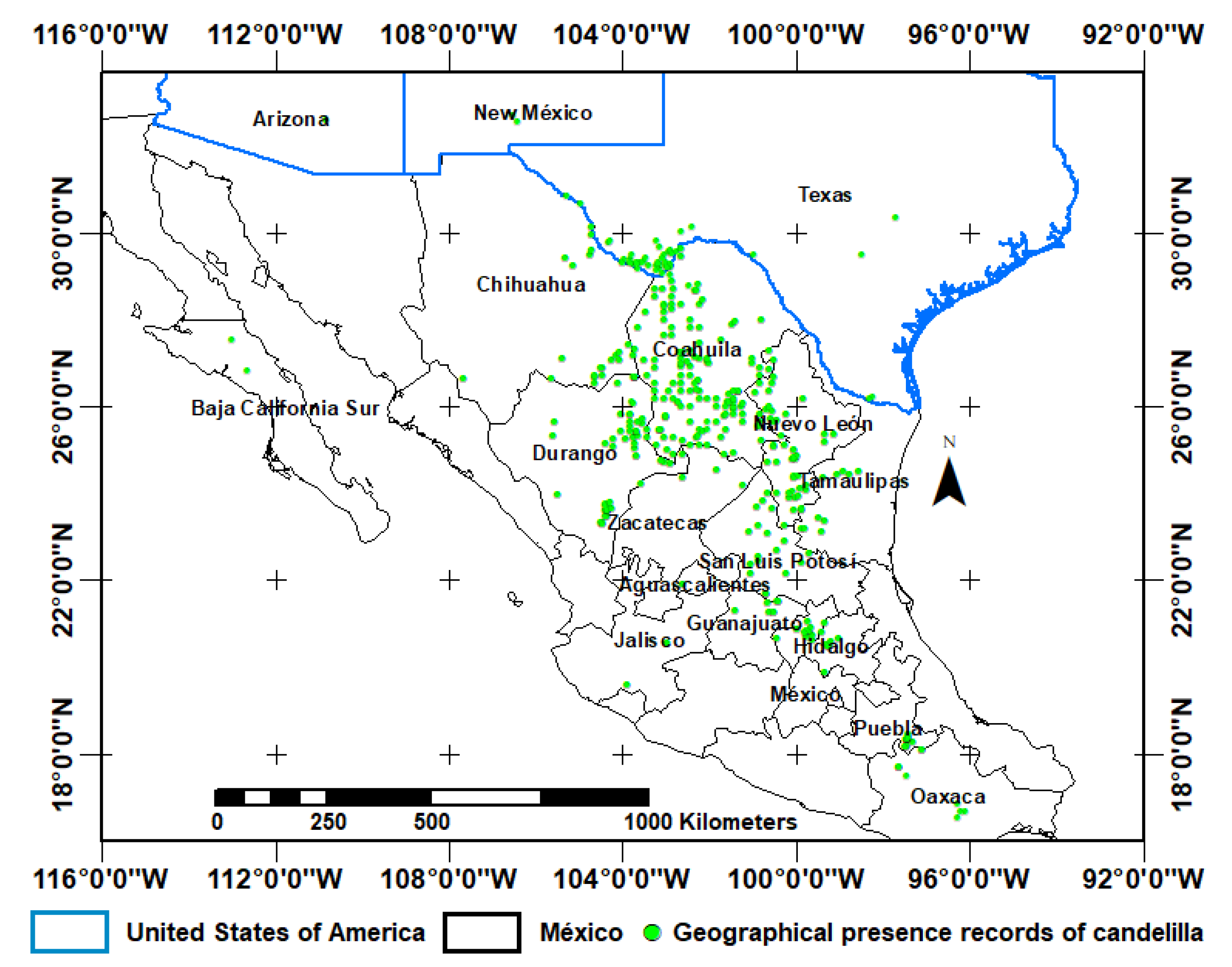
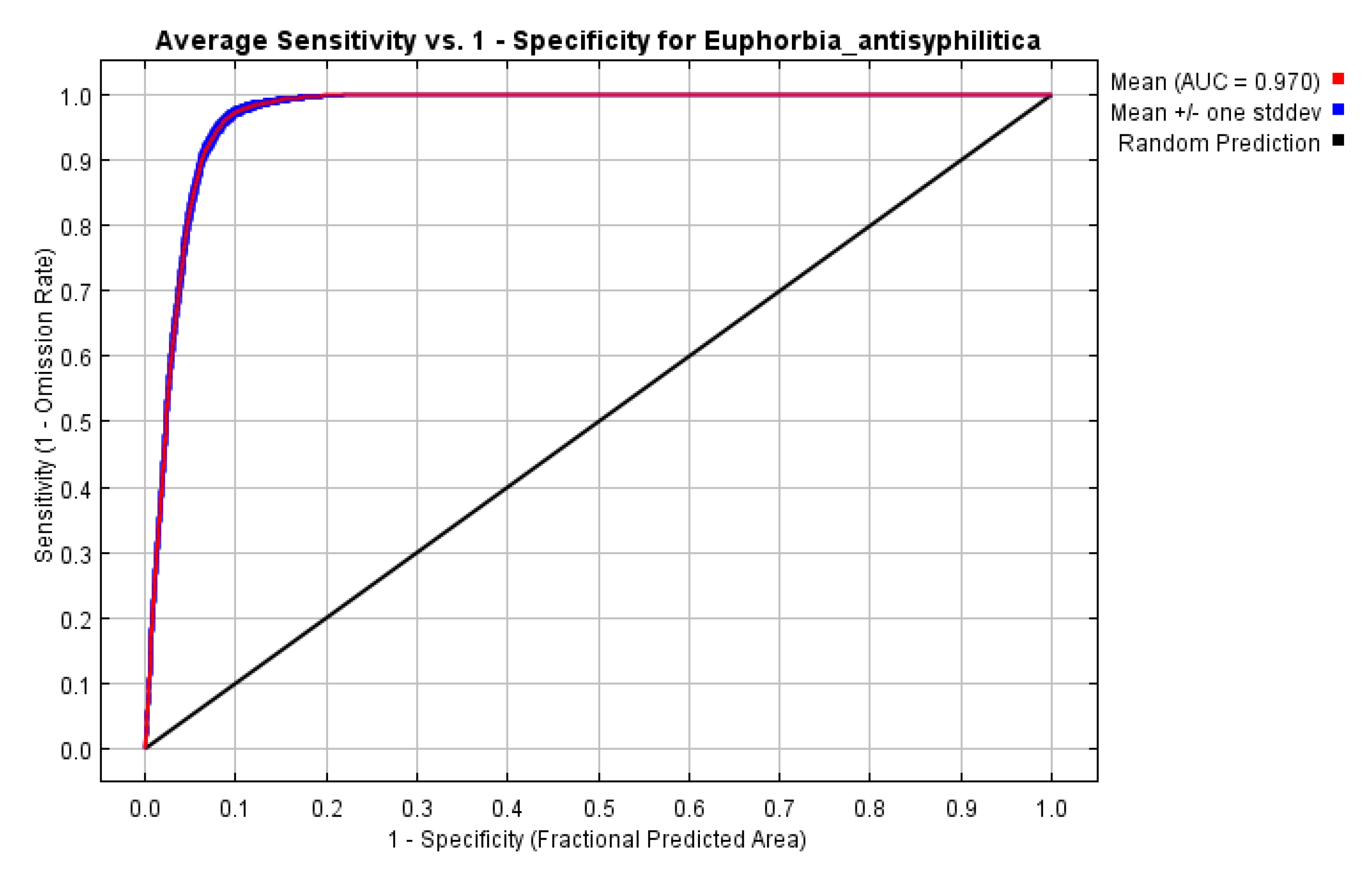
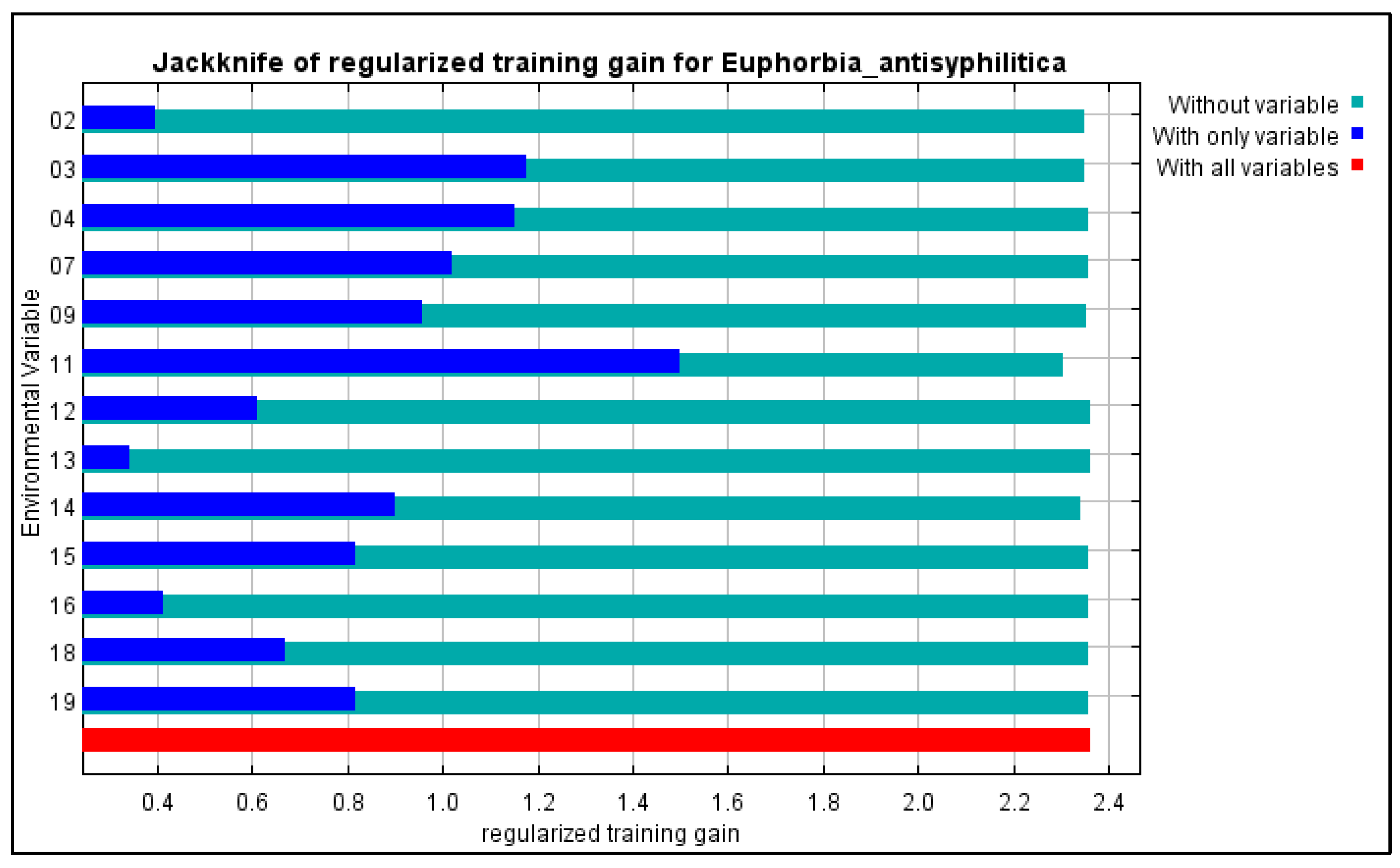
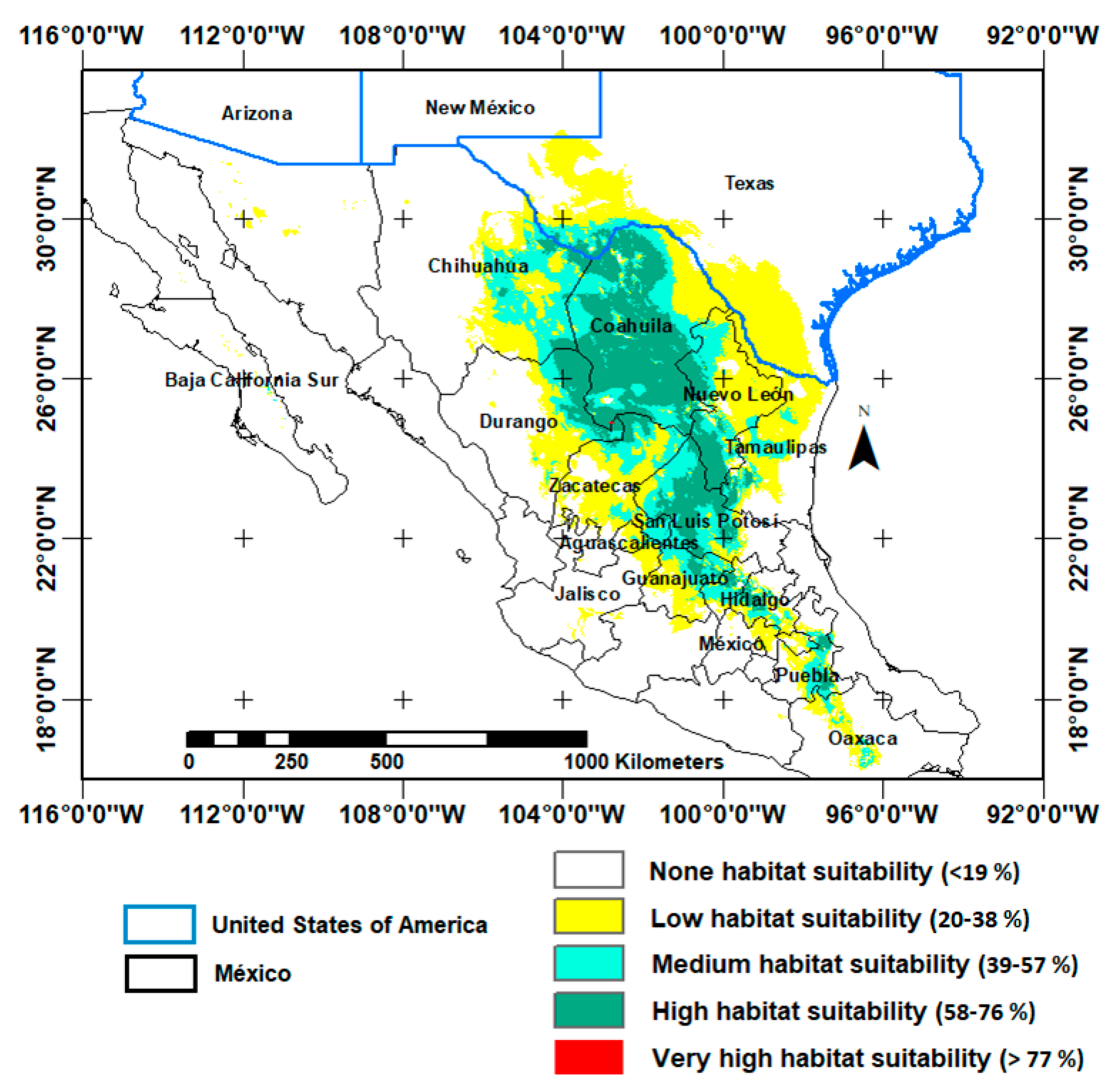
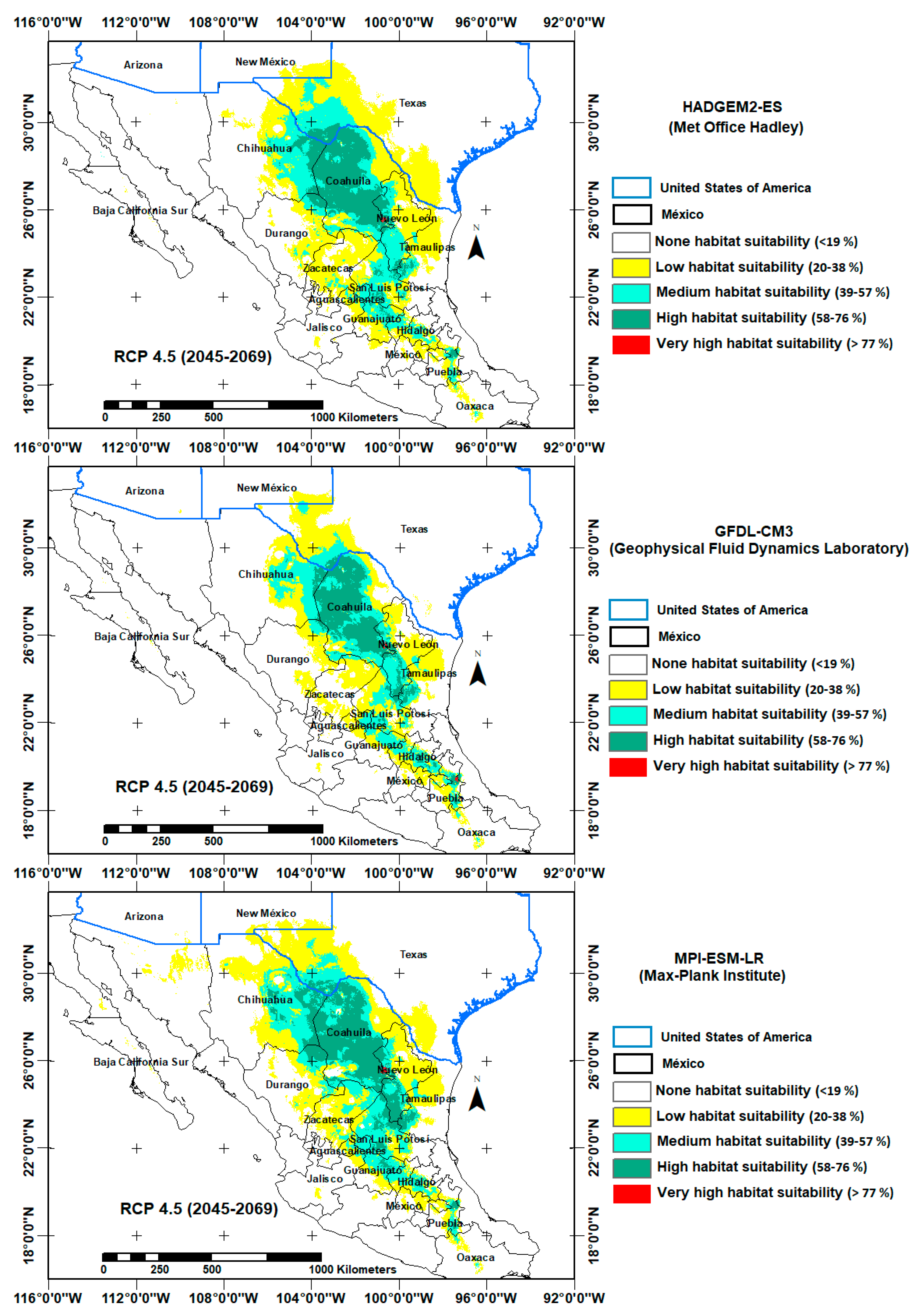

| Code | Environmental Variable | Unit | Contribution |
|---|---|---|---|
| Bio1 | Annual Mean Temperature | °C | |
| Bio2 | Mean Diurnal Range (Mean of monthly (max temp—min temp)) | °C | 1.9 |
| Bio3 | Isothermality (BIO2/BIO7) (×100) | 1.4 | |
| Bio4 | temperature seasonality (standard deviation ×100) | C of V | 1.0 |
| Bio5 | Max Temperature of Warmest Month | °C | |
| Bio6 | Min Temperature of Coldest Month | °C | |
| Bio7 | Temperature Annual Range (BIO5-BIO6) | °C | 1.7 |
| Bio8 | Mean Temperature of Wettest Quarter | °C | |
| Bio9 | mean temperature of driest quarter | °C | 8.7 |
| Bio10 | Mean Temperature of Warmest Quarter | °C | |
| Bio11 | Mean temperature of coldest quarter | °C | 45.7 |
| Bio12 | Annual Precipitation | mm | 4.5 |
| Bio13 | Precipitation of Wettest Month | mm | 0.9 |
| Bio14 | precipitation of driest month | mm | 4.7 |
| Bio15 | precipitation seasonality (coefficient of variation) | mm | 13.3 |
| Bio16 | Precipitation of Wettest Quarter | mm | 3.0 |
| Bio17 | Precipitation of Driest Quarter | mm | |
| Bio18 | Precipitation of Warmest Quarter | mm | 1.5 |
| Bio19 | precipitation of coldest quarter | mm | 11.6 |
| Model | Habitat Suitability | ||||
|---|---|---|---|---|---|
| None | Low | Medium | High | Very High | |
| (< 19%) | (20%–38%) | (39%–57%) | (58%–76%) | (>77%) | |
| Current conditions | 258,239,854 | 35,762,240 | 20,472,214 | 19,166,820 | 430 |
| GFDL-CM3 4.5 | 271,611,220 | 31,420,530 | 18,923,526 | 11,661,342 | 24,940 |
| HADGEM2 4.5 | 249,190,934 | 46,029,350 | 23,239,178 | 15,173,496 | 8600 |
| MPI-ESM-LR 4.5 | 251,931,668 | 40,811,730 | 23,755,178 | 17,110,216 | 32,766 |
| GFDL-CM3 8.5 | 279,306,328 | 27,304,398 | 16,429,784 | 10,545,664 | 55,384 |
| HADGEM2 8.5 | 250,376,272 | 47,687,086 | 23,284,156 | 12,262,396 | 31,648 |
| MPI-ESM-LR 8.5 | 264,142,894 | 33,837,818 | 25,283,742 | 10,375,556 | 1548 |
© 2020 by the authors. Licensee MDPI, Basel, Switzerland. This article is an open access article distributed under the terms and conditions of the Creative Commons Attribution (CC BY) license (http://creativecommons.org/licenses/by/4.0/).
Share and Cite
Vargas-Piedra, G.; Valdez-Cepeda, R.D.; López-Santos, A.; Flores-Hernández, A.; Hernández-Quiroz, N.S.; Martínez-Salvador, M. Current and Future Potential Distribution of the Xerophytic Shrub Candelilla (Euphorbia antisyphilitica) under Two Climate Change Scenarios. Forests 2020, 11, 530. https://doi.org/10.3390/f11050530
Vargas-Piedra G, Valdez-Cepeda RD, López-Santos A, Flores-Hernández A, Hernández-Quiroz NS, Martínez-Salvador M. Current and Future Potential Distribution of the Xerophytic Shrub Candelilla (Euphorbia antisyphilitica) under Two Climate Change Scenarios. Forests. 2020; 11(5):530. https://doi.org/10.3390/f11050530
Chicago/Turabian StyleVargas-Piedra, Gonzalo, Ricardo David Valdez-Cepeda, Armando López-Santos, Arnoldo Flores-Hernández, Nathalie S. Hernández-Quiroz, and Martín Martínez-Salvador. 2020. "Current and Future Potential Distribution of the Xerophytic Shrub Candelilla (Euphorbia antisyphilitica) under Two Climate Change Scenarios" Forests 11, no. 5: 530. https://doi.org/10.3390/f11050530





